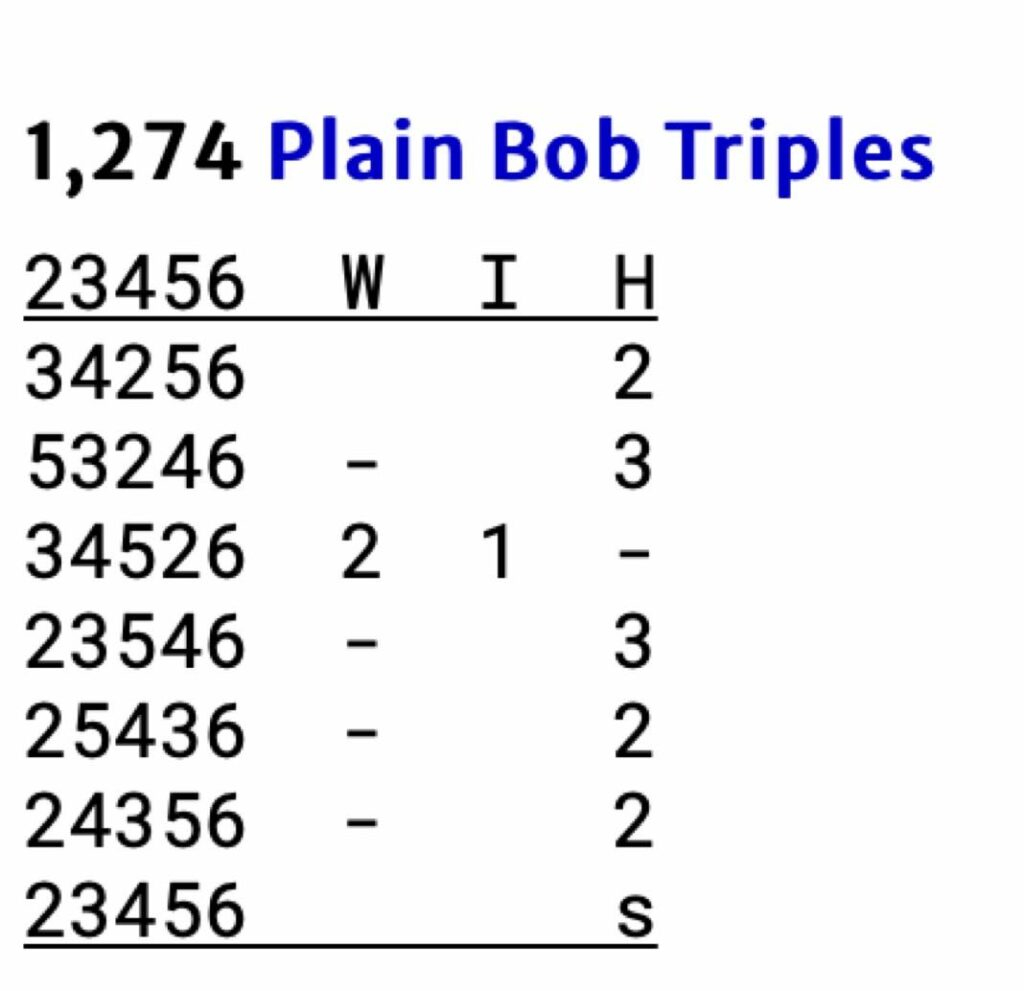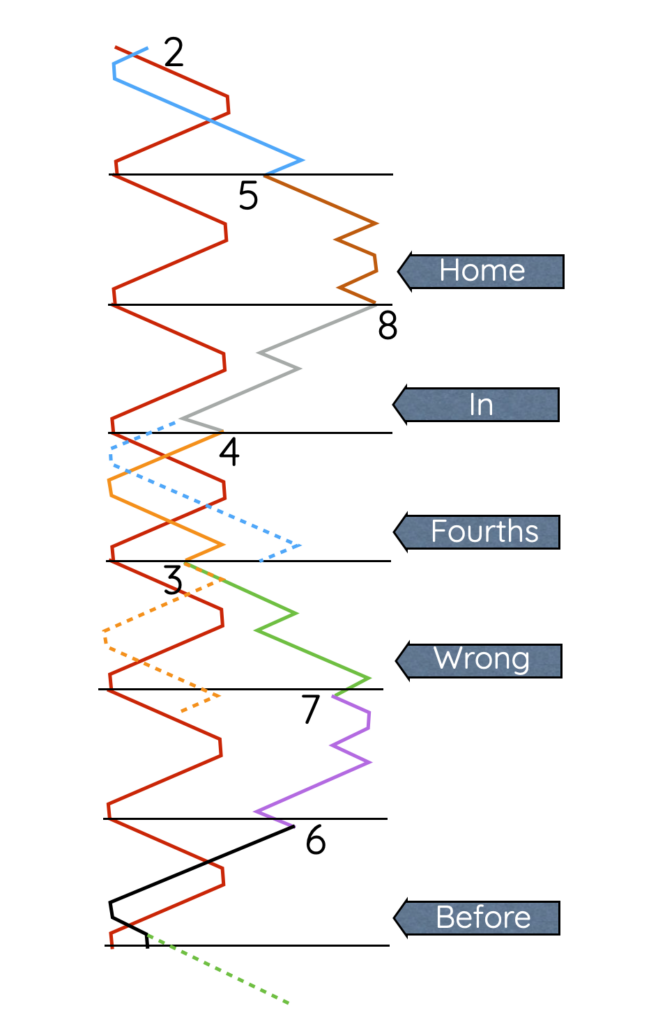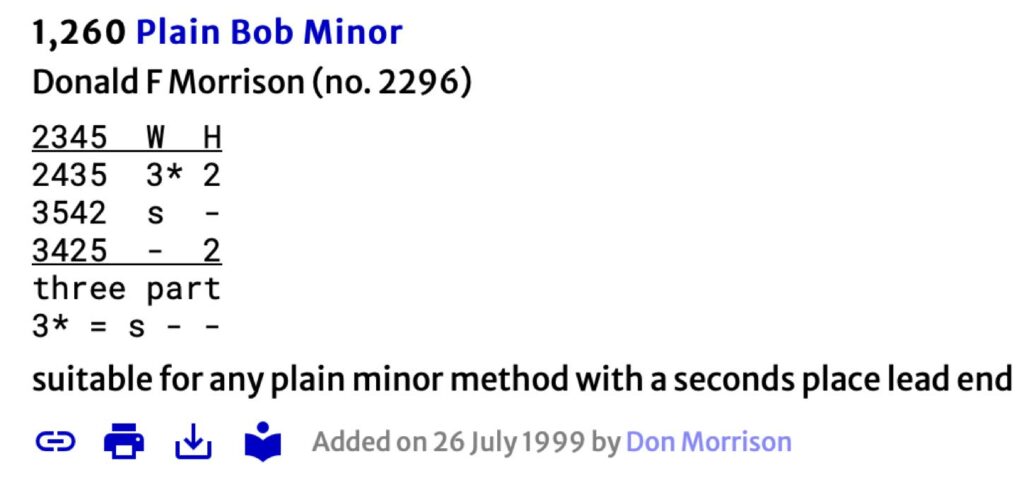What is a touch?
A touch is a piece of ringing which involves more than just a plain course. At the simple end, it could be a set of two, three or four bobs called to extend or truncate a piece of ringing and practice what to do when calls are made. At the other extreme, it could be a 3 hour peal.
Touches normally only include 1 method at a time, but can easily incorporate many calls and splices (changes of method midway) if required. Conducting and composing are essential parts of any touch and behind each one, will be a conductor and/or composer. The composer will design the touch, make sure it is the required length, does not repeat any changes and sounds good! A Conductor will call the Bobs and then make sure they are rung correctly, so the touch comes round correctly.
There are many different touches and compositions for us to ring and most use a standard shorthand to describe them.
Calls…
‘-‘ is used for a bob.
‘s’ is used for a single.
A number will imply repeated use of the same call. 3 will be 3 bobs in the specified place.

Calling positions…
Most compositions will be written as though you are ringing the last working bell. e.g. the 7 in triples or the 8 in major.
In most cases, the composition will provide the expected change after a call or group of calls. This is so the conductor can check that everyone has switched correctly.
It is possible to call most compositions from any bell. However, if you call from a different bell, you either have to transpose all the calls, or work out what the new changes will be. Because you will be starting from a different position all the mid points will be different.
Calling Positions

When you look at a composition, it will generally appear in a small table.
Normally, it will tell you what the method is and how long the touch is. In the illustration, you can see it is 1260 changes (a Quarter Peal) of St Nicholas Bob Triples.
The table will show where the Bobs and Singles should be placed…
Often there will be key changes listed, so you can check no one has got wrong. Remembering these part end numbers, whilst following your line and remembering to call the bobs can be quite tricky!
There may also be further information about what to expect.
What the letters mean...
W is for Wrong. The wrong position is the lead when the biggest bell is in the penultimate position… This is 5ths place bell in minor or triples, 7ths in major or caters. For even bell methods, this will generally be an ‘up’ dodge…
H is for Home. This the when the heaviest bell is moving back in its normal starting position. 7th place bell for triples, 6th for minor. The ‘home’ lead is when most compositions will come round.
M is for Middle. You will only see this in triples and above. Middle is the 3rd of the back positions for calling. It is at the beginning of 6th place bell for triples and major… 8th place bell for caters and royal. It is normally a ‘down’ dodge.
I is for In. This is where you run in and become 2nd place bell. It most commonly involves missing a 3-4 down dodge.
B for before and is where you run out and become 3rds place bell. It will always occur as the treble turns you from lead.
F is for fourths. It is where you ‘make the bob’ (make fourths) and become 4th place bell.
Most other positions on higher numbers will be denoted by the place bell number you will become.

Observation
An observation bell is most often the ‘conductors bell’. Generally, it denotes a bell which is unaffected by calls, or is only affected to a limited extent.
If a bell is unaffected it will be much easier to see what the other bells are doing. It is also much easier to work out timings and lengths.
From a composers point of view, it is normally assumed the observation bell is the heaviest working bell.
- In minor, only W and H are unaffected at a Bob, although 2nds could also be added for a single. For Triples, we can add middle and for major, 5th place. In Royal, there can be 6 or 7 unaffected bells at any call.
It is possible to create simple compositions which only use unaffected calls. Most other compositions will still use unaffected positions more than anything else.
Reading a composition

The composition shown above, we can see it is a composite 1260 of PB Minor. It includes all 720 possible permutations along with 540 more which are heard for a second time. It only uses wrong (5-6 up) and home (6-5 down) calls.
It is in three parts, so has to be repeated twice.
Each part is 7 courses long (420 changes):
A single and two bobs are called at 5-6 up (wrong) in the first three courses. A bob at 5-6 down (home) is also added at the end of the third course.
A second home is then added at the end of the fourth course. At which point the conductor can check the order as (1)24356.
In the fifth course a single is called at 5-6 up (wrong) and a bob at 5-6 down (home)… It ends (1)35246.
In the sixth, a bob is called at both wrong and home, followed by a bob home at the end of the seventh. It should then end (1)34256 with 1, 5 and 6 back in the right position. The other three bells are rotated around…
(1)34256 will become (1)42356 and (1)23456 at the end of parts 2 and 3.
When to Call...
In most normal methods, the calls come one pull before the lead end. Because the lead end is at back stroke, it means that the call will also be at back stroke.
In reality, the actual calling position i.e what you are doing… will depend on the method. As a general rule of thumb, it will be just before the lead end dodge or at the end of the lead/lie when turning. ‘6th/8th place’ methods are little more tricky as they have plain hunt at the lead end. You may need to think carefully about where to call, as it will be far less obvious.
It is general custom to make the call at the leading bell’s back stroke. If you are calling a home (and in 6th place), the call will actually be almost a whole stroke earlier… so a little after hand stroke. If you are calling a ‘before’, then as the leading bell, it will be at your own backstroke.
The exception to this is Grandsire and other double hunt bell methods. These methods have extended lead ends which start one blow before the lead end and continue for 3 blows. You need to call one blow earlier for these methods. This is normally when the treble is in 3rds place. Doubles variations also use these extended lead ends, so also need the same treatment.
Musicality
The best touches will have been designed to create as many pleasing changes as possible… This will be particularly important for higher number touches, as so few of the possible changes will be rung. Composers will often try to keep the back bells together… i.e coursing each other. This naturally occurs in a plain course too. It helps to stabilise the rhythm and also sounds good. 65 (minor) or 87 (major) changes at backstrokes are generally avoided. This is because an open hand stroke immediately after, will sound terribly incomplete. Ideally, all changes that end 65 or 87, etc., will be organised to occur at hand stroke. doing this means they can cartwheel onwards into the backstroke change.
Composers will also try to make sure they get lots of Combination Roll-Ups (CRUs), roll downs (Runs), and variations on named changes like tittums or queens too…
Many compositions will log or list how many of these ‘desirable’ changes are included. Any score in advance of 200 for a quarter peal would be considered excellent. However, for doubles and minor this will be almost irrelevant and most will have a similar score. this is because all the changes have to be rung anyway… be they good, bad or indifferent!

The above composition has a musicality score of 355 which is very high. It includes 64 different roll-ups (e.g 7654), as well as 12 x 5678’s and 33 other runs (e.g. 23456). It also includes 25, 468 (Queens like) changes including Kings (75312468).
